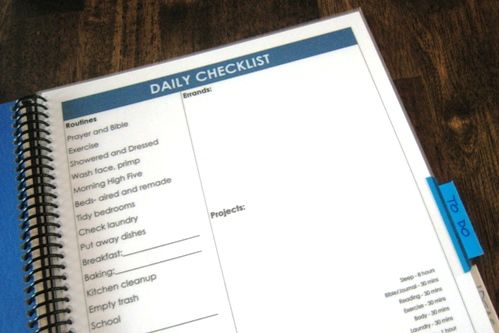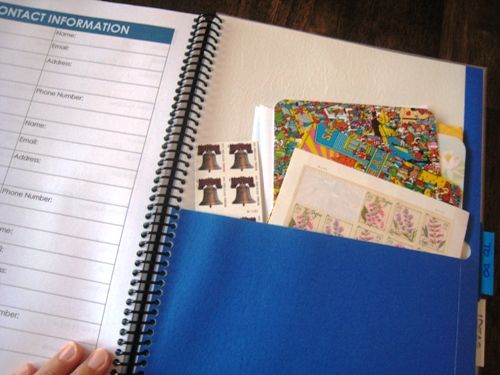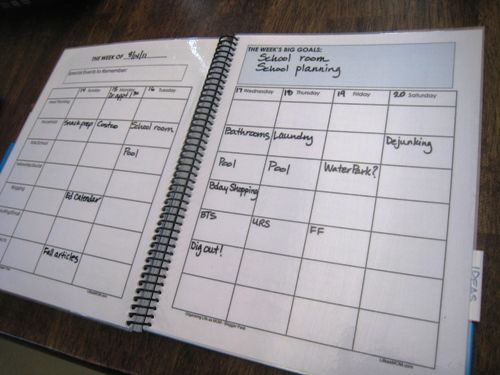Ever wake up and ask yourself, “How did I get here?”
Whether it’s an untidy house, a jumbled bank account, or an overpacked schedule, I’m stuck in chaos on more than one occasion. It may be because I am bursting with creativity or actively working on a project. Or I might be in such a fog of busy-ness, I can’t see clearly.
As moms we’re responsible for the welfare of others as well as ourselves. That’s the nature of the job. While we can’t do everything perfectly—nor should we try—it’s in our and our family’s best interests to put a little order into the chaos.
This is where paper comes to my rescue. Not only does writing things down help me make sense of my thoughts, it also helps me organize my life and my household. And I do it with my handy dandy notebook.

Tsh wrote years ago that her household notebook was her brain. I completely agree. I have so many thoughts floating in my head, I have to capture them somewhere, put them in order, and create a plan to give feet to my ideas.
A household notebook or personal planner is a great tool to help you manage your home and family responsibilities and to capture those elusive thoughts.
Where to start?
You don’t need to have a complicated planner system. When I was a tween, DayRunner came out with their inaugural planners. My mom and all her friends were smitten, but it seemed you had to take a class to figure out how to make it work for you. They would get together over coffee to try to make sense of all these papers and lists.
No, no, no. Let’s keep things simple.
1. Include some basic lists and records in your household notebook:
- a calendar
- a to-do list, like Tsh’s Daily Docket
- an address book
- the lists you find yourself creating over and over again, like a meal plan, a grocery list, or a checklist for road trips.

2. Tweak it to fit your needs.
We each have different needs, desires, and quirks when it comes to a personal planner or household notebook. I like to have separate binders for my homeschool records and for our financial records. My homeschool binder stays in our schoolroom because that’s where I use it. Our accounting book stays in the office where I pay the bills.
But, my personal/household notebook—my brain—goes with my everywhere. It’s lightweight and easily portable, and includes the things that I need throughout the day, like my meal plan, my calendar, my idea file, my shopping lists, my writing and blogging files, and my overarching goals for life. I even laminated some of the pages to save paper and to give me a fresh start on my daily to-do list.
Customize your book to fit who you are and what you need on a daily basis.
3. Bind it.
Many folks like to put their planning pages in a three-ring binder. I tried this for years, to no avail. I gave it up after a few months of lugging around an unwieldy book. A few years ago, I tried a new tactic and had mine spiral bound. Now, I take my notebook everywhere with me—and it serves me well, instead of taking up space in a cupboard.

Choose the packaging system that works for you and then put together a planner that rocks. Add color and fun accents to make it suit your personality.
4. Use it or lose it.
You’ve heard it before—“Have nothing in your home that you do not know to be useful or believe to be beautiful.” Make your household notebook work for you! Make it fit you and your life and your sense of style.
Last year I wrote an e-book that explains in more detail how to put together a household notebook, and how to maximize its potential to help you get your act together. The e-book is chock full of planning pages and inspiration for organizing your day, your home, your life. (And if you’re a homeschooler or a blogger, I’ve got those details covered, too.)
The most important thing to understand about a personal planner or household notebook is that it’s there to make your life easier, to help you keep track of your responsibilities and to free you up to do the things that matter most in your life.
Life is too short to spend it a day late and a dollar short. Make the most of your days and capture those elusive thoughts in a household notebook.
What’s your organizational system for keeping track of things?


